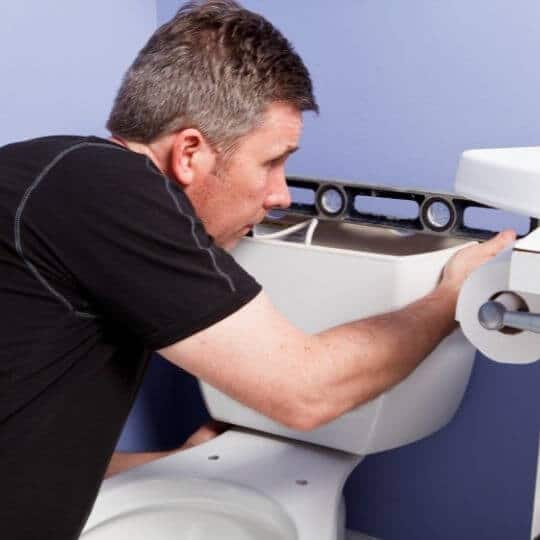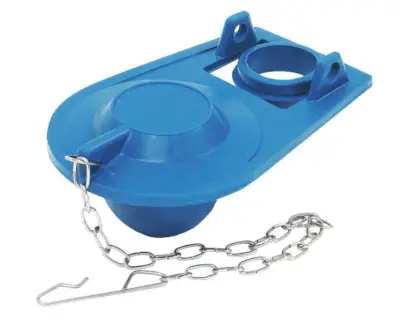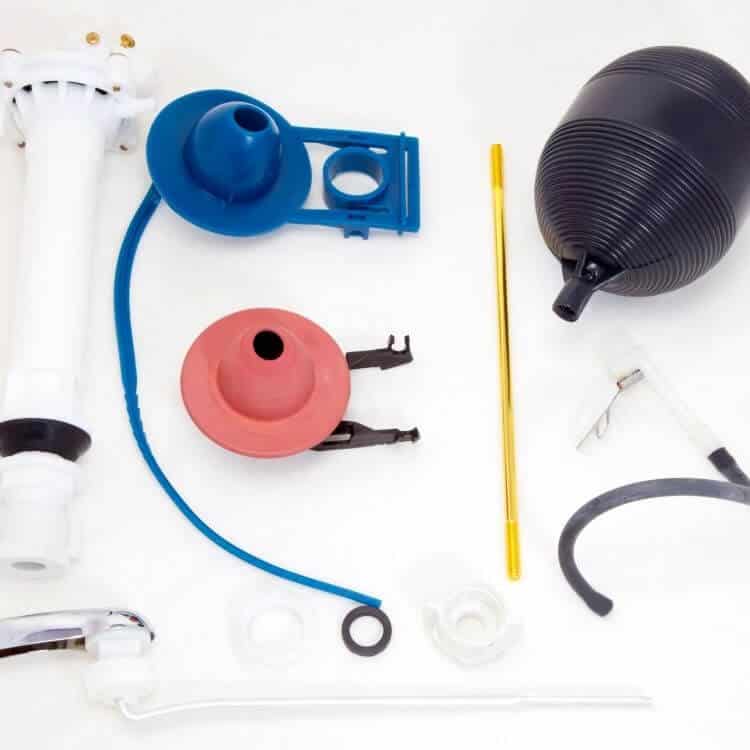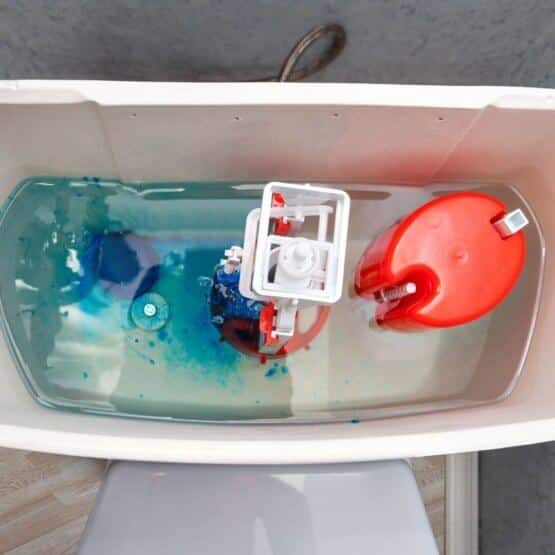When searching to replace a faulty flapper, one has to take into account different toilet flapper types. Replacing a toilet flapper is important, but what’s even more important is choosing the right one to buy.
We gathered all of the useful information about toilet flappers so you can successfully do this.
How Do Toilet Flappers Work?

Toilet flappers are not just any other toilet tank part. Without one, a toilet won’t be able to function properly at all.
In fact, what makes a toilet flapper so important is that it allows water to flush down the toilet.
A toilet flapper is a rubber piece that sits at the very base of the toilet tank and has two main purposes. When closed, it serves as a seal so no water can leak into the toilet bowl when the toilet is not being used.
The very important purpose of a toilet tank is to stop the water from exiting the toilet tank. The other important function of a toilet flapper is to also allow the water to exit properly when you flush.
What lifts the toilet flapper is the chain attached to it. That same chain is connected to the lever or a handle that you press or pull down when you want to flush.
Depending on the toilet and the toilet tank model, a model of the toilet flapper can also vary. Toilet flapper types affect the way in which they detect when to stop the water from exiting the tank.
Toilet flappers are used very frequently and have a crucial role in the flushing process. They can get worn out due to decay over time, or because of the chemicals found in water or used in cleaners.
When overused, a toilet flapper will leak, causing constantly running water or even more problems along the way.
Are Toilet Flappers Universal?

It’s possible to find a toilet tank that is different from one that you have right now, and that perfectly fits, as well. However, this doesn’t make toilet tanks universal.
Toilet tanks that are different, but do fit your toilet, are found within the same category of toilet tanks. This means that you can choose a different toilet tank if you’re careful about the category of the one you currently have.
A similar thing about toilet flappers is that there are toilet flappers made to replace some of the ones on the market. However, most toilet flappers are not universal.
This piece of information is of crucial importance for anyone looking to replace their toilet flapper. Toilet flappers vary in size, and sometimes even in their design.
To choose the right toilet flapper, you need proper drain diameter measurements. [1]
If the flapper is improperly sized, it can leak water. Keep in mind that toilet tanks and toilet bowls can vary in size and design, too.
Taking into account the size of your toilet tank can prevent the mistake of having a chain of incorrect size. A chain that is too short will not allow the toilet flapper to work properly, even though the flapper is correct in size.
Toilet Flapper Types

When it comes to toilet flapper types, there are 3 most common types that you can see on the market.
Each of them operates differently, so it’s best to first identify the one that matches with the one you currently have. This way you will ensure you have the right mechanism in place.
Identifying the toilet flapper you currently have is simple.
Make sure to turn off the water valve and empty the toilet tank by flushing. Then, open the tank lid and simply inspect the look of the toilet flapper.
Here, we will provide you with a description of all 3 main toilet flapper types and the way they work.
When you find the one that matches the look of your faulty one, that’s the one you should go for. However, stick with us as we will explain how to take proper measurements further in the article.
The 3 most common toilet flapper types go as follows:
- Seat Disk Flapper
Seat Disk Flappers are arguably the oldest type of toilet flappers out there.
This flapper is a disk connected to a system in the toilet tank that keeps it covering the base of the tank. The disk placed like this prevents the water from gushing out the toilet.
After you press the lever, a system of levers lifts up this disk and a water reservoir keeps it lifted until the flushing is done. It’s done when the reservoir empties, therefore becoming light enough to lower the disk again.
Since this is the oldest type of toilet flapper, it’s usually the hardest one to find a replacement for. It’s usually causing the most problems as its aged mechanism is not as successful as the one in the newer toilets.
- Rubber Flapper
In contrast to seat disk flappers, rubber flappers are the ones that came on the market more recently.
The way rubber flappers work is that they are connected to a chain, which is also connected to a lever. When you push down on a lever, the chain lifts the rubber flapper, allowing the water to exit the tank.
The rubber flapper closes again by its own weight after it detects the water refill in the tank.
This is also what allows a user to control how long the flush will last. This feature is very convenient for saving water for smaller flushes.
Also, it’s one of the reasons why the rubber flapper is so common and popular.
However, don’t be confused by its name – some of them are not made completely of rubber. There are variations to this type and you can find the ones made of different materials.
What does make the rubber flapper recognizable is that they always have a rubber rim, no matter the inside material.
- Tank Ball Flapper
Most tanks have some kind of ball with the purpose to balance the tank refill. There are some types of tanks that have a tank ball flapper that also serves to control the water exiting the tank.
This is when we speak of a tank ball flapper. The way a ball flapper works is that it fills with water and drops down when it gets heavy.
The heaviness of the ball will be affected by the heaviness of the toilet tank being refilled with water. This is how a flapper of this type detects it’s time to seal the bottom opening of the tank.
Like a rubber flapper, a tank ball flapper is also connected to a chain, and sometimes with a rod. Both of these types can malfunction when worn out or if the chain is too short, allowing the water to leak.
If you have a modern type of toilet, you most likely have a rubber flapper. A tank ball flapper and a tank disk are more commonly used in some older types of toilets.
Other Toilet Flapper Types

Apart from the 3 most common types of toilet flappers we just discussed, there are also some other flapper types out there. These usually come as variations to the 3 main types we just discussed:
- Rubber Flapper With a Chain Float
This one comes with a mix of the tank ball and rubber flapper features. In fact, the flapper itself is just a rubber flapper that’s used very commonly.
However, the chain it’s attached to has a float on it. The purpose of this chain float is to allow a flapper to be open for longer periods of time.
By adjusting the chain float lower or higher, you control the use of water as this controls when the flapper closes. This is a very beneficial feature and is one of the best ways to optimize your flushing. [2]
- Rubber Flapper With a Control Dial
This flapper works very similarly to the previous variation. In fact, its use is also to save up water with added features to do so.
The only thing that makes it different is that this flapper doesn’t have a float attached to the chain. It’s also a rubber flapper with a chain, but without the float.
What it has instead is the control dial built in the rubber flapper itself. It’s recognizable by having built-in numbers, and the switch that allows you to control how much water is being used to flush.
How to Choose the Right Toilet Flapper?
Are you still wondering what is the best toilet flapper to buy?
Whether you decide to replace a flapper by using a repair kit or purchasing a flapper, you have to take some measurements.
The easiest way to identify your toilet flapper is to measure across the flapper you already have. Choosing the correct size of the flapper is crucial as it serves to seal the tank opening.
The sizes of toilet flappers nowadays vary from 2 to 4 inches. However, what you’ll notice is that most toilets have a 2 to 3 inches drain, and the ones measuring 2 inches are the most common.
If you are unsure, it’s best to not only measure a flapper but also measure the diameter of the drain valve opening.
Depending on the toilet and toilet tank model, you might also need a flapper that is adjustable. There are flexible flappers available that are made from material that stretches to cover the drain opening.
The best toilet flapper to buy is the one that matches the size of your current one, as well as the mechanism of your toilet tank.
How to Know if Your Toilet Flapper Is Bad?

There are plenty of reasons why toilet flappers might fail. Noticing the signs your toilet flapper needs replacement is important so you can act quickly and prevent further damage.
Some of the signs of a bad toilet flapper include:
- A constantly running toilet water
- A tank needs more time than usual to refill with water
- Low water pressure from the tank
- Toilet overflowing but not clogged
A toilet that flushes by itself and does so often can also create other problems if not solved quickly. When a constantly running toilet meets a clog further down the drain, your toilet can overflow.
This is why it’s important to replace toilet flappers every 4 to 5 years. However, if you do notice some of the signs in the meantime, you should replace the flapper and not wait.
Let’s take a look at some of the most common reasons your toilet flapper needs replacement.
- It Got Worn Out
A worn out toilet flapper can be the reason why your toilet tank won’t fill with water.
It’s best to know when the initial flapper has been placed inside a tank. After 4 or 5 years, it’s very common for the material of the flapper to get worn and cause leaks.
- Corrosion
If the water is of bad quality, the internal parts of the tank can easily corrode, which can deteriorate the materials.
This, in turn, affects the proper function of toilet parts. Corrosion in the water pipes can also be detrimental to your health, especially if you’re drinking it. [3]
- Mold Growth
In some older toilets that are not checked at all, the bacteria and mildew can grow and develop very quickly.
When this built-up debris attaches to the toilet tank parts, it can lead to their improper function. Make sure you clean out the water tank in this case, as mold can harm your health. [4]
The Bottom Line
To conclude, there are many toilet flapper types, and toilet flappers are not universal.
If you’re searching to replace your current toilet flapper, you need to take proper measurements prior to the purchase.
The best way to be sure you chose the right flapper is also to inspect the current mechanism in your toilet tank. By matching some key features, your toilet will work well as new!

Michael Davis is a heating & plumbing expert who currently works as independent contractor in SC. He also writes for Plumbertip.
For almost 10 years he worked on various plumbing tasks across South Carolina.


